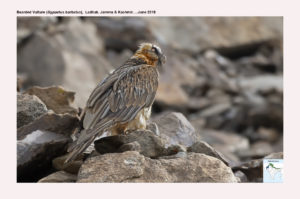Bearded Vulture

Bearded Vulture Gypaetus barbatus
Etymology :
- Gypaetus : Greek word gups- vulture; aetos- eagle
- Barbatus : Latin word for “bearded” derived from barba – beard
Vernacular Names : Hindi: Argul, H.P.: Okhab
Distribution in India: Resident in Himalayas in India.
Description: Size of 94–125 cm; wt. of 4500–7100 g; wingspan of 231–283 cm. It is a large raptor with small beard of blackish feathers at base of bill, creamy-yellow irides, red eye ring and long, wedge-shaped tail. The wings, dorsum, tail and facial mask are blackish; rest of head, neck and underparts are rich orange . This is resulting from active impregnation by mineral particles; individuals very occasionally maintain original whitish coloration. The feet are lead-grey. The females tend to have longer wing feathers and to be heavier than males. The juvenile are all dark, with broader wings and paler feet than adult;. The juvenile goes through various transitional plumages. It is found in mountain ranges with rugged topography and rocky sites at which species nests and breaks bones. It visits surrounding plains, and also areas of tableland. It requires large open areas with little or low vegetation, not continually covered with snow. It relies on thermals and winds for gliding flight, but to much lesser extent than most other vultures. It breeds at variable elevations400–4400 m in Indian Subcontinent and has been seen at 8000m in Himalayas.
Food habits: The diet is unique among vertebrates as it is dominated by bones, which make up 70–90% of all food. It prefers old bones to fresh ones, perhaps because they are lighter, large bones to small ones and bones with high fat content. It is partial to leg bones of medium-sized livestock like sheep and goats, on which diet is often based, or wild ungulates. It eats both marrow and bone itself, and also bits of meat and skin. It swallows small bones whole and carries bones it cannot break or swallow up into air and drops them from 20–80 m or more onto favoured rocky area. Then it descends in spiral to eat the smaller pieces that result of the fall. It occasionally steals prey caught by other birds. It surveys enormous areas: adult has home range of up to thousands of square km which may overlap with those of neighboring adults. It stores food at nest, in cave or even at ossuary.
Breeding habits: They breed in Dec–Feb or Mar in Europe, Asia and N Africa and May–Jul in South Africa. They nest on cliffs, mainly in caves, sometimes on ledges. The nest is a large mass of sticks, lined with wool and other materials like animal skin and hair. Each pair normally alternates between various nests. They lay a clutch of 1–2 eggs, laid at interval of 5–7 days. The incubation period is 52–56 days, starting with first egg. Only 1 chick survives owing to aggression by older chick. Both parents take part in nest building, nest defense, incubation, brooding and feeding of chick. The fledging occurs at 103–133 days.